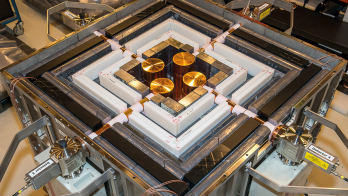By José W F Valle and Jorge C Romão
Wiley-VCH
Paperback: £75 €€90
Also available at the CERN bookshop

Neutrinos have kept particle physicists excited for at least the past 20 years. After they were finally proved to be massive, two mass-squared differences and all three mixing angles have now been determined, the final remaining angle, θ13, in 2012 by the three reactor experiments: Daya Bay, RENO and Double Chooz. As neutrino masses are expected to be linked intimately to physics beyond the Standard Model that can be probed at the LHC, and as neutrinos are about to start a “second career” as astrophysical probes, it seems a perfect time to publish a new textbook on the elusive particle. The authors Jose Vallé and Jorge Romão are leading protagonists in the field who have devoted most of their careers to the puzzling neutrino. In this new book they share their experience of many years at the forefront of research.
They begin with a brief historical introduction, before reviewing the Standard Model and its problems and discussing the quantization of massive neutral leptons. The next three chapters deal with neutrino oscillations and absolute neutrino masses – the mass being one of the fundamental properties of neutrinos that is still unknown. Here the authors give a detailed discussion of the lepton-mixing matrix – the basic tool to describe oscillations – and seesaw models of various types. An interesting aspect is the thorough discussion of what could be called “Majorananess” and its relation to neutrino masses, lepton-number violation and neutrinoless double beta decay – for example, in the paragraphs dealing with the Majorana–Dirac confusion and black-box theorems, a point that is rarely covered in text books and often results in confusion.
Next, the book discusses how neutrino masses are implemented in the Standard Model’s SU(2) × U(1) gauge theory and the relationship to Higgs physics. This is followed by a detailed treatment of neutrinos and physics beyond the Standard Model (supersymmetry, unification and the flavour problem), which constitutes almost half of the entire book. Here the text exhibits its particular strength – also in comparison to the competing books by Carlo Giunti and Chung Kim, and by Vernon Barger, Danny Marfatia and Kerry Whisnant, both of which concentrate more on neutrino oscillation phenomenology – by discussing exhaustively how neutrino physics is linked to physics beyond Standard Model phenomenology, such as lepton-flavour violation or collider processes. The inclusion of a detailed discussion of these topics is a good choice and it makes the book valuable as a textbook, although it does make this part rather long and encyclopedic. Another strong point is the focus on model building. For example, the book discusses in detail the challenges in flavour-symmetry model building to accommodate a non-zero θ13, and the deviation of the lepton-mixing matrix from the simple tri-bi-maximal form.
The authors end with a brief chapter on cosmology, concentrating mainly on dark matter and its connection to neutrinos. While this chapter obviously cannot replace a dedicated introduction to cosmology, a few more details such as an introduction of the Friedmann equation could have been helpful here. In general, the treatment of astroparticle physics is shorter than expected from the title of the book. For example, the detection of extragalactic neutrinos at IceCube is not covered – indeed, IceCube is only mentioned in passing as an experiment that is sensitive to the indirect detection of dark matter. Also leptogenesis and supernova neutrinos are mentioned only briefly.
The book mainly serves as a detailed and concise, thorough and pedagogical introduction to the relationship of neutrinos to physics beyond the Standard Model, and in particular the related particle-physics phenomenology. This subject is highly topical and will be more so in the years to come. As such, Neutrinos in High Energy and Astroparticle Physics does an excellent job and belongs on the bookshelf of every graduate student and researcher who is seriously interested in this interdisciplinary and increasingly important topic.








